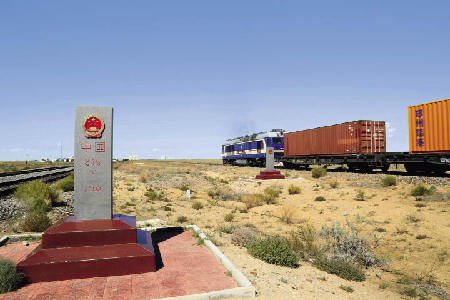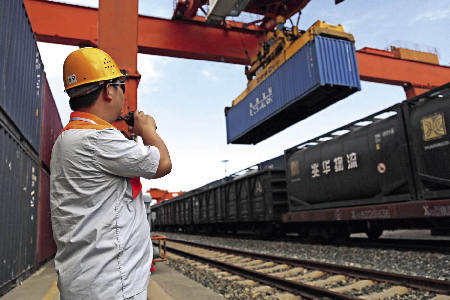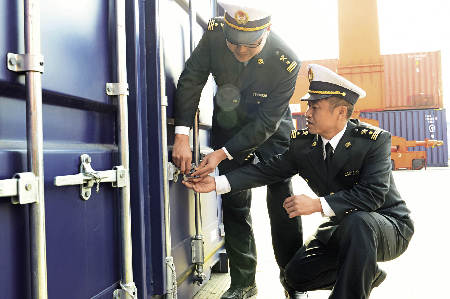China’s Rail Freight Goes International
By staff reporter LUO YUANJUN HUANI, 40, from Shandong runs an international freight forwarding firm. She revolutionized her business mode after a conversation with the proprietor of a coffee shop during a recent trip to Switzerland. He told her that the coffee she was drinking had just arrived from China via specialized rail freight, in half the time it would have taken by ocean carriage. Ground coffee imported this way is fresher, with a mellower aroma. This information galvanized Huani. At that time, air and marine transportation were her clients’ main choices. As the former is fast but expensive, and the latter cheap but slow, her chat in Switzerland about coffee prompted Huani to look into rail services. She found the costs of rail freight reasonable and that it is quicker than sea transportation. It therefore seemed the ideal choice for her clients. After investigating international cargo trains running between China and the EU, Huani found that they operate from several cities in China’s inland, including Chongqing, Chengdu, Zhengzhou, Wuhan, and Changsha. As of October 29, 2015, there were 1,058 freight trains linking cities in China with 11 cities in seven European countries, Zhong Cheng, vice general manager of China Railway Container Transport Co., Ltd., said at the 2015 Summit on the Silk Road Economic Belt and Globalization Strategy of China’s High Speed Railways.
The Zhengzhou-Europe international shuttle train crosses the border at Erenhot in Inner Mongolia Autonomous Region.

Worth a Try
Huani found out after checking on the Internet that the Shandong-Xinjiang-Europe rail service started on August 28, 2015. It entailed trains between Shandong Province’s Binzhou City to Europe via Xinjiang in northwestern China, and as from October that year also between the province’s Linyi City to Europe via Manzhouli in northeastern China. She decided to act on this good news for Shandong’s foreign trade entrepreneurs and give cargo trains a shot.
Huani carried out extensive research before embarking on this new transport mode. Reserving a freight car requires provision of original documentation and specifying the code of the destination station. Once goods are freighted, cargo consignors can no longer claim ownership. Payment for such goods must consequently be made in advance.
China-Europe rail freight services now extend from Eastern to Western Europe. They are in diversified forms that include both specialized and regular trains that meet the demands and scales of different customers. For instance, the Hogood Coffee Express service aimed at larger customers started on July 16, 2015 on the Chongqing-Xinjiang-Europe international railway line. For small and medium-sized customers, the Linyi-Manzhouli-Europe fast freight train is the best choice. Goods under the 152 categories that qualify for fast transportation in sporadic batches can be collected from the doorstep after the shipper has negotiated a price and signed an agreement guaranteeing transportation safety.
Linyi in southeastern Shandong is China’s second-largest wholesale trade hub and site of the largest small commodity market in North China. It sells everything from construction materials to daily necessities. In recent years, the volume of goods transported from Linyi to Europe via Manzhouli has expanded rapidly, so signifying a rising demand in the West. The Linyi-Manzhouli-Europe rail cargo service is thus a significant facilitator of export business.
Huani chose the Linyi-Manzhouli-Europe line when she first started incorporating rail services into her business, and her clients are happy with this change. Although rail services are costlier than sea transportation, they are a competitive alternative, particularly for perishable goods and high added value products. Rail freight avoids such risks as typhoons and stranding, and also shortens the return on capital, so saving on bank loan interest.
“The government encourages development of international freight rail services,” Huani said. “Taking into account government subsidies on freight charges, they are little different from those for sea transportation.”
|
|
|
A cargo train sets off from Xi'an in northwest China to Alma-ata in Kazakhstan. By July 24, 2015, 100 freight trains had been sent to the Central Asian country by Xi'an Railway Administration. |
Diversified Services
The first regular cargo train linking China and Europe set out from China’s Chongqing to Duisburg, Germany on March 19, 2011. Since then, three routes for China-Europe freight rail services have opened. The western route runs through central and western China and leaves the country via Alashankou or Khorgos in Xinjiang Uygur Autonomous Region. The central route travels across northern China and through the border city of Erenhot in Inner Mongolia Autonomous Region. The eastern route travels southeastern coastal areas and exits China either from Manzhouli in Inner Mongolia or Suifenhe in Heilongjiang Province. Today, China-Europe cargo trains depart from a good number of provinces around the country, including Shandong, Jiangsu, Jilin, Liaoning, Fujian, Hubei, Sichuan, and Zhejiang.
The Suzhou-Manzhouli-Europe freight train service that started on May 12, 2014 has since upgraded its operation mode. Suzhou Customs and their counterpart in Manzhouli have enhanced cooperation to heighten the customs clearance efficiency of international cargo trains. Customs procedures are completed in Suzhou after goods for export have been loaded for departure. Cargo information is then sent via the Internet to Manzhouli Customs, where the goods undergo a sampling inspection upon arrival. This new mode shortens the period of transportation and saves on logistics costs.
Suzhou Customs also use advanced technologies and digital facilities to simplify clearance formalities. Declarations are made at the Customs office where the goods are loaded, and rapid clearance can be carried out when trains cross the country’s border. According to this policy, cargos go through a one-stop customs declaration, checking, and clearing procedure. For optimum convenience the service also includes specialized declaration channels and 24-hour customs clearance by appointment.
Su Min, one of Huani’s clients, has worked in Sino-European trade for years. “Not that long ago we needed first to take goods to the railway station by car. Now we can dispatch them from our doorstep. This saves costs and improves competitiveness among companies,” Su Min said.
The Linyi-Manzhouli-Europe rail has a different operation model. An international logistics company based in Shandong runs the freight service, and cargo handling is carried out on a designated rail line. Contracts are signed with the local rail operator, consignors and the logistics company. Loading and unloading procedures are supervised and guided to ensure safety. At the same time, discount on fixed freight prices is available.
Huani explained that in the past, freight costs were payable at each section of rail along the route. A few years later a fixed price was implemented whereby freight costs were paid in one go. Another improvement in 2015 was that of railway administrations of different sections offering discounts on large quantities of goods traveling long distances.
|
|
|
Chinese customs staff check carriages before the first cargo train linking Yiwu in east China and Madrid in Spain is launched on November 18, 2014. |
Likely Profits
Cargo trains travelling between China and Europe, however, do not break even financially, because trains returning from Europe usually carry loads far lighter than those they depart with. Other than a few routes, such as Chongqing-Xinjiang-Europe and Zhengzhou-Europe, rail freight services do not operate in both directions. The Chongqing-Xinjiang-Europe rail service did not bring cargos back to China until two years after it had started.
This may be attributable to the structure of Sino-European trade. Of the 70 million-plus tons of goods transported over land routes and the more than 200 million tons of goods conveyed by sea transportation each year between China and Europe, the majority are China exports. EU exports to China mainly comprise precision instruments, machinery, and high-end garments, which are generally not transported by train.
Transporting goods back to China, therefore, is a common topic among international cargo train operators. In October 2014, China’s State Council ratified parallel car imports in certain pilot zones. Since then, more premium automobiles have been transported to China from Europe via rail services.
On May 29 and 30, 2015, Tuanjiecun Station in Chongqing took delivery of the largest number of cars transported from Europe via the Chongqing-Xinjiang-Europe route since the launch of the parallel car imports policy. The 10 or so trading companies that have set up offices for finished automobiles in the area imported around 1,500 cars last year. More free trade zones throughout the country, including Shanghai, Tianjin, and Nansha, have also begun parallel importing of cars. This trend is expected to expand numbers of potential international freight rail service customers.
To truly appreciate the benefits of China-Europe cargo trains, Huani would also like to purchase a car so imported.


